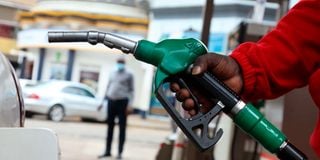Fuel consumption falls to lowest level in 5 years amid high prices

A fuel attendant holding a fuel pump at the filling station along Kimathi Street. Fuel consumption has dropped.
Fuel consumption in the six months to December last year dropped to the lowest level in at least five years, highlighting the impact of record-high pump prices amid doubling of Value Added Tax (VAT).
Data from the Energy and Petroleum Regulatory Authority (Epra) shows that consumption of diesel, super petrol and kerosene fell five percent to 2.28 billion litres in the period compared to 2.4 billion litres used in the second half of 2022.
This is the lowest recorded in Kenya at least since 2019 and came at a time prices breached the Sh200-a litre mark in some towns after VAT on petroleum products was doubled to 16 percent effective July 1, 2023.
Pump prices jumped by up to Sh13 a litre when Epra adjusted prices to reflect the new VAT rate of 16 percent.
A litre of super petrol jumped by Sh13.49 to Sh195.53 while that of diesel rose by Sh12.39 to Sh179.67 in Nairobi.
Kerosene prices increased by Sh11.96 to Sh173.44.
A free-falling shilling and global rally in prices of refined fuel further added to the impact of the new VAT rate of 16 percent.
The last time that consumption was close to the levels seen in the second half of last year was in the same period of 2019 at 2.38 billion litres.
Prices rose further from September 15 last year, with a litre of diesel hitting Sh200.99 from Sh179.67 in Nairobi while that of super petrol rose to Sh211.64 from Sh194.68.
Diesel— the main fuel that drives the economy — dropped five percent to 1.26 billion litres in the review period compared to 1.33 million litres consumed in the second half of 2022 while super petrol fell four percent to 991.8 million litres from 1.02 billion litres.
The Kenyan economy runs mainly on diesel with prices of the commodity key in determining transport costs, the cost of power generation and agricultural activities.
Kerosene—mainly used by low-income homes for lighting and cooking— took the biggest hit of more than half with 15.2 million litres consumed in the second half of the year last year from 35 million litres in the same period in 2022.
Fuel consumption for the second half of last year was lower than in the same period of 2020 when travel and economic activities remained subdued as the country slowly eased the coronavirus restrictions.
Consumers used 2.49 billion litres of the three fuels in the second half of 2020 on slowed economic activities as the country battled Covid-19.
Motorists, businesses and homes grappled with the highest fuel prices in Kenya’s history between October and December last year on a combination of increased taxation and a global rally in the cost of refined fuel.
Kenya has one of the highest taxation rates on fuel, with nine taxes that account for at least 31 percent of the price per litre.
Prices remained on a climb and hit Sh217.36 per litre of super petrol effective October 15 last year while diesel jumped to Sh205.47 a litre. The cost of kerosene increased to Sh205.06 in that period.
Pump prices have since eased mainly on the continued drop in the cost of refined fuel in the global market with a litre of diesel going for Sh196.47 while that of super petrol is retailing at Sh207.36 in the monthly pricing cycle that lapses today at the stroke of midnight.




